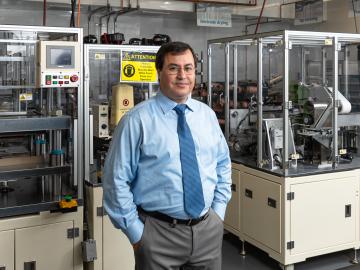
Filter News
Area of Research
- Advanced Manufacturing (1)
- Biology and Environment (32)
- Computational Biology (1)
- Computer Science (3)
- Electricity and Smart Grid (1)
- Energy Science (51)
- Energy Sciences (1)
- Functional Materials for Energy (2)
- Fusion and Fission (2)
- Fusion Energy (1)
- Isotopes (3)
- Materials (34)
- Materials for Computing (5)
- National Security (20)
- Neutron Science (16)
- Nuclear Science and Technology (2)
- Quantum information Science (1)
- Supercomputing (34)
News Topics
- (-) Artificial Intelligence (22)
- (-) Bioenergy (32)
- (-) Biomedical (28)
- (-) Composites (4)
- (-) Energy Storage (46)
- (-) Frontier (11)
- (-) Mercury (2)
- (-) National Security (19)
- 3-D Printing/Advanced Manufacturing (40)
- Advanced Reactors (18)
- Big Data (20)
- Biology (33)
- Biotechnology (5)
- Buildings (17)
- Chemical Sciences (20)
- Clean Water (7)
- Computer Science (59)
- Coronavirus (34)
- Critical Materials (6)
- Cybersecurity (11)
- Element Discovery (1)
- Environment (65)
- Exascale Computing (11)
- Fossil Energy (1)
- Fusion (20)
- Grid (20)
- High-Performance Computing (19)
- Hydropower (8)
- Irradiation (1)
- Isotopes (12)
- ITER (2)
- Machine Learning (18)
- Materials (39)
- Materials Science (53)
- Mathematics (2)
- Microscopy (21)
- Molten Salt (2)
- Nanotechnology (26)
- Neutron Science (47)
- Nuclear Energy (41)
- Partnerships (8)
- Physics (23)
- Polymers (12)
- Quantum Computing (7)
- Quantum Science (23)
- Security (7)
- Simulation (6)
- Space Exploration (6)
- Summit (24)
- Transportation (25)
Media Contacts

With the rise of the global pandemic, Omar Demerdash, a Liane B. Russell Distinguished Staff Fellow at ORNL since 2018, has become laser-focused on potential avenues to COVID-19 therapies.

Scientists have tapped the immense power of the Summit supercomputer at Oak Ridge National Laboratory to comb through millions of medical journal articles to identify potential vaccines, drugs and effective measures that could suppress or stop the

Oak Ridge National Laboratory researchers have developed a thin film, highly conductive solid-state electrolyte made of a polymer and ceramic-based composite for lithium metal batteries.

Researchers at Oak Ridge National Laboratory demonstrated a 20-kilowatt bi-directional wireless charging system on a UPS plug-in hybrid electric delivery truck, advancing the technology to a larger class of vehicles and enabling a new energy storage method for fleet owners and their facilities.

Suman Debnath, a researcher at ORNL, has been elevated to the grade of senior member of the Institute of Electrical and Electronics Engineers (IEEE).

Researchers at the Department of Energy’s Oak Ridge National Laboratory (ORNL) in late February demonstrated a 20-kilowatt bi-directional wireless charging system installed on a UPS medium-duty, plug-in hybrid electric delivery truck.

In the race to identify solutions to the COVID-19 pandemic, researchers at the Department of Energy’s Oak Ridge National Laboratory are joining the fight by applying expertise in computational science, advanced manufacturing, data science and neutron science.

Ilias Belharouak is leading ORNL’s research efforts in investigating new materials for solid-state batteries, which can double the charging capacity of lithium-ion batteries, commonly used today for electronic devices such as cell phones.

A versatile class of flexible, protein-like polymers could significantly advance future drug delivery methods. But first, scientists have to develop a reliable process for tailoring these polymers into shapes that can effectively transport medicines throughout the human body.

Researchers at the Department of Energy’s Oak Ridge National Laboratory have used Summit, the world’s most powerful and smartest supercomputer, to identify 77 small-molecule drug compounds that might warrant further study in the fight


